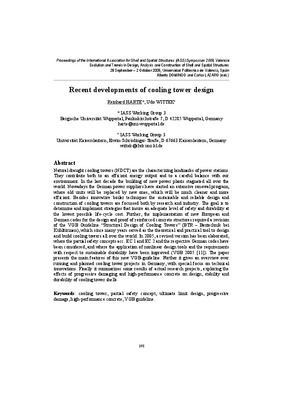JavaScript is disabled for your browser. Some features of this site may not work without it.
Buscar en RiuNet
Listar
Mi cuenta
Estadísticas
Ayuda RiuNet
Admin. UPV
Recent developments of cooling tower design
Mostrar el registro sencillo del ítem
Ficheros en el ítem
| dc.contributor.author | HARTE, Reinhard
|
|
| dc.contributor.author | WITTEK, Udo
|
|
| dc.contributor.editor | Domingo Cabo, Alberto
|
es_ES |
| dc.contributor.editor | Lázaro Fernández, Carlos Manuel
|
es_ES |
| dc.date.accessioned | 2009-11-25T14:13:17Z | |
| dc.date.available | 2009-11-25T14:13:17Z | |
| dc.date.issued | 2009-11-25T14:13:17Z | |
| dc.identifier.isbn | 978-84-8363-461-5 | |
| dc.identifier.uri | http://hdl.handle.net/10251/6483 | |
| dc.description | p. 198-210 | en_EN |
| dc.description.abstract | Natural draught cooling towers (NDCT) are the characterizing landmarks of power stations. They contribute both to an efficient energy output and to a careful balance with our environment. In the last decade the building of new power plants stagnated all over the world. Nowadays the German power suppliers have started an extensive renewal program, where old units will be replaced by new ones, which will be much cleaner and more efficient. Besides innovative boiler techniques the sustainable and reliable design and construction of cooling towers are focussed both by research and industry. The goal is to determine and implement strategies that insure an adequate level of safety and durability at the lowest possible life-cycle cost. Further, the implementation of new European and German codes for the design and proof of reinforced concrete structures required a revision of the VGB Guideline ¿Structural Design of Cooling Towers¿ (BTR ¿ Bautechnik bei Kühltürmen), which since many years served as the theoretical and practical tool to design and build cooling towers all over the world. In 2005, a revised version has been elaborated, where the partial safety concepts acc. EC 1 and EC 2 and the respective German codes have been considered, and where the application of nonlinear design tools and the requirements with respect to sustainable durability have been improved (VGB 2005 [11]). The paper presents the main features of this new VGB-guideline. Further it gives an overview over running and planned cooling tower projects in Germany, with special focus on technical innovations. Finally it summarizes some results of actual research projects, exploring the effects of progressive damaging and high-performance concrete on design, stability and durability of cooling tower shells. | en_EN |
| dc.language | Inglés | en_EN |
| dc.publisher | Editorial Universitat Politècnica de València | es_ES |
| dc.relation.ispartof | Symposium of the International Association for Shell and Spatial Structures (50th. 2009. Valencia). Evolution and Trends in Design, Analysis and Construction of Shell and Spatial Structures : Proceedings | en_EN |
| dc.rights | Reserva de todos los derechos | en_EN |
| dc.subject | Cooling tower | en_EN |
| dc.subject | Partial safety concept | en_EN |
| dc.subject | Ultimate limit design | en_EN |
| dc.subject | Progressive damage | en_EN |
| dc.subject | High-performance concrete | en_EN |
| dc.subject | Vgb guideline | en_EN |
| dc.title | Recent developments of cooling tower design | en_EN |
| dc.type | Comunicación en congreso | en_EN |
| dc.rights.accessRights | Abierto | es_ES |
| dc.description.bibliographicCitation | Harte, R.; Wittek, U. (2009). Recent developments of cooling tower design. Editorial Universitat Politècnica de València. http://hdl.handle.net/10251/6483 | es_ES |
| dc.relation.conferencename | Symposium of the International Association for Shell and Spatial Structures | es_ES |
| dc.relation.conferencedate | 2009 | es_ES |
| dc.relation.conferenceplace | Valencia | es_ES |






